Construction and career
Mullett was laid down at the Rotherhithe yard of Charles Lungley on 29 June 1859 and launched on 3 February 1860. She was fitted with a Robert Napier & Sons two-cylinder horizontal single-expansion steam engine driving a single screw and developing 355 indicated horsepower (265 kW ). [1]
She was fitted out at Deptford Dockyard, and this would have included her armament of a 68-pounder 95 cwt muzzle-loading smooth-bore gun, two 24-pounder howitzers and two 20-pounder breech-loading guns. All ships of the class later had the 68-pounder replaced by a 7-inch/110-pounder breech-loading gun. The class were fitted with a barque-rigged sail plan. [1]
West Africa (1862–1866)
After commissioning at Sheerness on 30 April 1862, she sailed for the West Africa Squadron under the command of Commander Cortland Herbert Simpson. She stayed there for a number of years and participated in at least one punitive expedition.
On an evening in October 1862, open mutiny broke out in the Gold Coast Artillery Corps at Cape Coast. The authorities dispatched Mullett to Accra to forestall a similar outbreak. There was no loss of life. Although 80 mutineers were court martialled and two were sentenced to death, their sentences were commuted. [2]
On 28 June 1866, Mullett, under Captain Robinson, and in company with the small colonial steamer Dover, landed a force of about 400 British troops under Colonel D'Arcy, primarily from the West India Regiment, at Bathurst in the Gambia. The force, joined by local allies, stormed a Marabout stronghold after Mullett had ineffectively shelled the stockade with her 68-pounder for four hours. The British suffered several dead in their attack. [3]
North America and West Indies Station (1867–1870)
From 7 November 1867 Commander Edward Kelly commanded Mullett on the North America and West Indies Station. In 1869, while the ship was in Jamaica, Able Seaman William Wardell won a Royal Humane Society Bronze Medal for saving the life on 10 June of Robert Cleal, an armourer of Terror. Cleal had fallen overboard and Wardell jumped in, holding Cleal above water until a lifebuoy was thrown to him. Cleal was unconscious when brought aboard Mullett but was revived. [4] Mullett paid off at Sheerness on 19 July 1870. [5]
Mercantile service (1872–1890)
The Admiralty sold her in Hong Kong on 25 April 1872 for mercantile use. She had her engines removed by W Walker & Co of London, converting her to a barque-rigged sailing vessel. Under the name Formosa she made several voyages to the Antipodes. [6]
Ultimately she was purchased at Melbourne. Then during the Russian war scare in the late 1880s, the government of Victoria bought several old vessels, including Formosa as blockships for the south and west channels. The scare passed and in 1890 the government converted Formosa to a magazine. [6]

The Defence-class ironclads were a class of two warships built for the Royal Navy between 1859 and 1862. The ships were designed as armoured frigates in response to an invasion scare sparked by the launch of the French ironclad Gloire and her three sisters in 1858. They were initially armed with a mix of rifled breech-loading and muzzle-loading smoothbore guns, but the Armstrong breech-loading guns proved unreliable and were withdrawn from service after a few years.
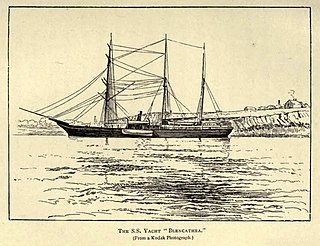
The Philomel-class gunvesselHMS Newport was launched in Wales in 1867. Having become the first ship to pass through the Suez Canal, she was sold in 1881 and renamed Pandora II. She was purchased again in about 1890 and renamed Blencathra, taking part in expeditions to the north coast of Russia. She was bought in 1912 by Georgy Brusilov for use in his ill-fated 1912 Arctic expedition to explore the Northern Sea Route, and was named Svyataya Anna, after Saint Anne. The ship became firmly trapped in ice; only two members of the expedition, Valerian Albanov and Alexander Konrad, survived. The ship has never been found.

The Camelion class was a class of screw-driven sloops of wood construction, designed by Isaac Watts and operated by the Royal Navy. Eight ships of the class were built from 1858 to 1866 with another eight cancelled. They were initially rated as second-class sloops, but were later reclassified as corvettes.

The Algerine-class gunboats were a class of six 3-gun wooden gunboats built for the Royal Navy in 1857. A further pair were built in India for the Bombay Marine in 1859.

The Mariner class was a class of six 8-gun gunvessels built for the Royal Navy between 1883 and 1888. Four were built in the Naval Dockard at Devonport, and two elsewhere; the Acorn was built by contract at Jacobs Pill on the Pembroke River, while the Melita was built in the Malta Dockyard, the only substantial ship of the Royal Navy ever to be built in the island.

HMS Surprise was a Vigilant-class gunvessel of the Royal Navy. She was launched at Blackwall Yard, London in 1856 and broken up in Plymouth in 1866.

The Vigilant-class gunvessel of the Royal Navy was an enlarged version of the Arrow-class gunvessel of 1854. Both classes were designed for shallow-water operations in the Baltic and Black Seas during the Crimean War. Fourteen of the class were completed, but were ready too late to take part in that conflict. Cormorant was sunk in action at the Taku Forts, Osprey was wrecked on the coast of Africa in 1867 and the rest were all sold during the 1860s, with Sparrowhawk lasting until 1872.

HMS Rapid was an 11-gun Rosario-class wooden-hulled screw-driven sloop of the Royal Navy, launched on 29 November 1860 at Deptford Dockyard and broken up in 1881.

The Comus class was a class of Royal Navy steam corvettes, re-classified as third-class cruisers in 1888. All were built between 1878 and 1881. The class exemplifies the transitional nature of the late Victorian navy. In design, materials, armament, and propulsion the class members resemble their wooden sailing antecedents, but blended with characteristics of the all-metal mastless steam cruisers which followed.

The Condor-class gunvessel was a class of four Royal Navy composite gunvessels of 3 guns, built between 1876 and 1877. They were all hulked or sold before 1893, giving them an active life of less than 15 years.

HMS Eclipse was a 4-gun Cormorant-class first class gunvessel launched in 1860 from the shipyard of J. Scott Russell & Co., Millwall. She served on the Australia Station, took part in the Second Taranaki War, including contributing men to a naval brigade which attacked the Maori stronghold at Gate Pā. The entire class were never satisfactory as gunvessels, partly due to their excessive draught, and Eclipse was broken up at Sheerness in 1867, only 7 years after her launch.
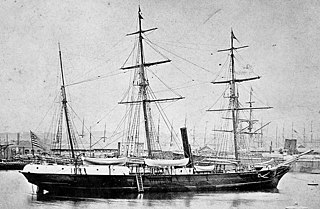
The Philomel-class gunvessel was a class of wooden-hulled screw-driven second-class gunvessels built for the Royal Navy between 1859 and 1867, of which 26 were ordered but only 20 completed. They had a mixed history, with some serving for as little as 5 years, and others surviving into the 1880s. Two of the class were sold and used as Arctic exploration vessels, both eventually being lost in the ice.

HMS Myrmidon was a Cormorant-class gunvessel of the Royal Navy, built at Chatham Dockyard and launched in 1867. She served on the North America and West Indies Station and surveyed parts of the Australian coast before being sold at Hong Kong in 1889.

HMS Barracouta was the last paddle sloop built for the Royal Navy. She was built at Pembroke Dockyard and launched in 1851. She served in the Pacific theatre of the Crimean War, in the Second Opium War and in the Anglo-Ashanti wars. She paid off for the last time in 1877 and was broken up in 1881.
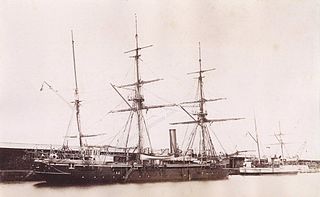
HMS Rambler was an Algerine-class gunvessel of the Royal Navy, built by John Elder & Co., Glasgow and launched on 26 January 1880. She was commissioned as a survey vessel in 1884 and served in Chinese waters during the 1880s and 1890s. She provided men to a naval brigade during the Boer War and was sold on 23 January 1907. The work of this vessel is now remembered in Hong Kong by the Rambler Channel near Tsing Yi.

The Algerine-class gunvessel was a class of three Royal Navy composite gunvessels built in 1880. Two of them were sold after only ten years of service, but the other was converted to a survey ship before commissioning and survived in this role until 1907.
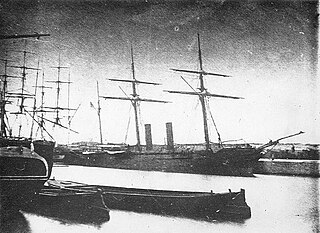
Intrepid-class gunvessels were a class of six Royal Navy first-class wooden gunvessels built in 1855-56. They were rated as sloops from 1859 to 1862, and were scrapped by 1865. Victor was sold to the Confederate States of America as the raider CSS Rappahannock, but she was interned by the French at Calais and never fulfilled her intended function.
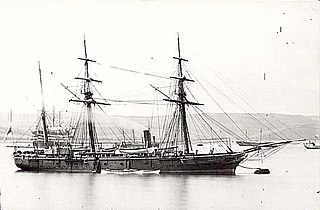
The Arab-class gunvessels were a pair of composite gunboats built for the Royal Navy in the mid-1870s.

HMS Arab was an Arab-class composite gunvessel built for the Royal Navy in 1874. She served in the East Indies and was sold in 1889.

The Cormorant-class gunvessels were a class of 4-gun first-class gunvessels built for the Royal Navy in the 1860s. They were somewhat unsuccessful; intended for shore bombardment in shallow water, they exceeded their design draft by 50%. Seven of the 13 ships ordered were suspended, with 3 finished or converted as survey ships and the other 4 cancelled. Racehorse was wrecked after only 4 years, and those ships that were completed as planned had short operational lives, in some cases less than 10 years. The survey vessels lasted longest, with the last ship of the class, Sylvia, being broken up in 1890.
















